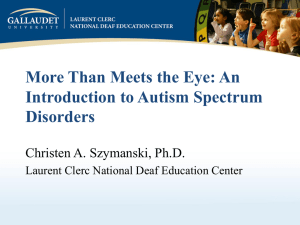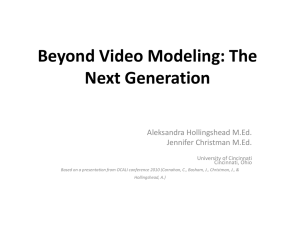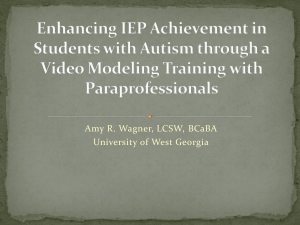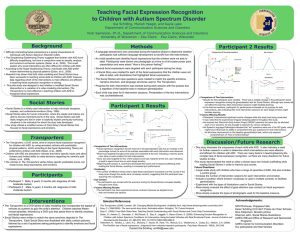Let`s Face It!
advertisement
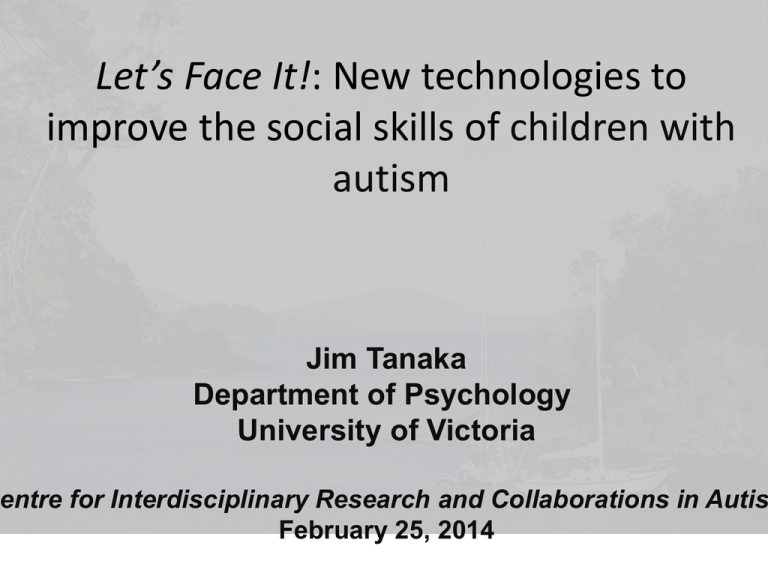
Let’s Face It!: New technologies to improve the social skills of children with autism Jim Tanaka Department of Psychology University of Victoria entre for Interdisciplinary Research and Collaborations in Autis February 25, 2014 Presentation Outline 1. The nature of face processing 2. The assessment of face processing 3. Technology-based interventions (Centre for Autism Research Technology & Education – CARTE) • Facial expression production • Can we build social networks through iPad apps? Faces are special Faces carry a wealth of information about who we are, what we are feeling and what we are thinking Identity Expression Eye Gaze Most of us can perform these face processing skills so accurately and effortlessly that we can be referred to as “face experts”. Children with autism are face “novices • Spend significantly less time looking at faces and eyes (Dalton et al. 2005; Klin et al., 2002, 2009) • Difficulty recognizing facial identity (Weigelt, Koldewyn & Kanwisher, 2012, Wolf et al. 2009) • Difficulty interpreting facial expressions (Harms et al., 2010; Tanaka et al., 2012) Visual fixation patterns during viewing of naturalistic scenes (Klin et al., 2002) Brain activation of fusiform “face” area in neuroimaging (Schultz,Face 2005) Response Fusiform “Face” Area Control Group Autism Group Fusiform “Face” Area Horizontal (Coronal) View Schultz, et al. 2000 Let’s It! Assessments What Face face processes are impaired in autism?: Let’s Face It! Test Battery Wolf et al. 2009, Autism Research 85 children and adolescents with ASD and 85 Full Scale IQ- and age-matched control participants were administered a battery of face processing measures. Recognition of identity across changes in expression Probe Faces Study Face Recognition of identity across changes in viewpoint Probe Faces Study Face Recognition of expression across changes in identity Probe Faces Study Face Tanaka et al., 2012. J of Child Psych & Psychiatry Results: Children with autism have difficulty creating abstract face memories Abstract Identity Representation Angry Shaun Scared Shaun Shaun Happy Shaun Abstract Expression Representation Happy Julie Happy Meg Happy Happy Billy Same/Different Faces Featural Mouth Configural Eyes Same/Different Houses Featural Configural A “difference” model rather than a “deficit” model of autism Children on the autism spectrum have perceptual strengths as well as weakness. Autism Strength: Attention to detail Can you find this object hidden in the geometric pattern? ? Can we train up face expertise (like other forms of perceptual expertise) in children with autism? The Let’s Face It! Program • Computer-based intervention in face perception and recognition • A science- and evidence-based approach • Seven different game activities emphasizing face processing skills in eye gaze, recognition of identity and expression Tanaka, Wolf, Schultz et al. 2010, J. of Child Psychology & Psychiatry A sample of the Let’s Face It! computer activities LFI! Intervention Study • Children diagnosed with autism spectrum disorder were prescreened with a battery of subtests (the Let’s Face It! Skills battery) examining face and object processing abilities. • In a randomized clinical trial (RCT), participants who were significantly impaired in their face processing abilities were assigned to either a treatment (N = 42) or waitlist (N =37) group. • Children in the treatment group received 20 hours of face training with the Let’s Face It! (LFI!) computer-based intervention over 3 to 4 month period and were then retested. Performance was compared to Time 1 and Time 2 waitlist group. Tanaka, Wolf, Schultz et al., 2010, Journal of Child Psychology & Psychiatry Part/Whole Task: Holistic face recognition Study Face Part Test Item Whole Face Test Item Results In the randomized clinical trial, children who played the Let’s Face It! games for 20 hours outperformed children from the ASD control group on measures of holistic perception. The Let’s Face It! Home Page Download software at no-charge from: web.uvic.ca/~letsface/letsfaceit Approximately, 1500 downloads to date from over 90 countries A promising start but . . . we are still confronted with the “Small Screen to Big World” problem of transfer and generalization. Facial expressions by persons on the autism spectrum Individuals on the AS are “flat” produce “flat” facial expressions Their facial expressions are often disorganized or inappropriate to the social context People on the AS can mimic other’s expressions, but have difficulty posing expressions (e.g., “smile for the camera”) in the absence of a model. The role of facial expressions for regulating social interactions Big Bang Theory’s Sheldon receives a smiling lesson from Leonard & Howard. Can we train facial expression production in children with autism? Centre for Autism Research, Technology and Education (CARTE) “New tools for different minds” Our mission: To produce accessible, low-cost or free technologies for children with ASD that are empirically and theoretically grounded in the cognitive and brain sciences. The Computer Expression Recognition Toolbox (CERT) Marni Marni Bartlett, Machine Perception Lab, University California, San Diego SmileMaze Avatar < Insert CERT Demo Here > 1.) Does playing FaceMaze improve the quality of facial expressions? Participants 20 children with Autism Spectrum Disorder (7 – 16 years of age) (Gordon et al., under review) The posed expression reveals the participant’s motoric representation of emotion Show us your “happy” face Show us your “angry” face Does playing FaceMaze improve the quality of facial expressions? Pre-Training Expression Pose 5 minutes of Smile Maze or Angry Maze Happy Angry Surprise (control) Pre-Training Post-Training Expression Pose Happy Angry Surprise (control) Post-Training Ratings of happy expressions before and after playing Smile Maze Before After Ratings of angry expressions before and after playing Angry Maze Before After 2.) Friendship and loneliness in children with ASD Friendship is defined as an intimate relationship providing ‘‘companionship, mutual support, and affection’’ (Freeman & Kasari, 1998, p. 341) Loneliness is an undesirable feeling associated with negative affect, heavily dependent on peer influences (Margalit, 1994). Social-cognitive loneliness gives rise to feelings of exclusion, meaningless, marginality and boredom (Weiss, 1973). Children with autism report being lonelier and having fewer friendships than their TD counterparts (Bauminger & Kasari, 2000). Social networks of children with ASD Can we enhance the real-world social networks of children with AS through mobile apps? Introducing Let’s Face It! 2.0 and the iScrapbook Acknowledgements Collaborators • Bob Schultz (Children’s Hospital of Philadelphia) • Julie Wolf (Yale Child Study Centre) • Marni Bartlett (UCSD) • Iris Gordon, members of VizCogLab & CARTE, University of Victoria Funding National Sciences and Engineering Research Council of Canada, National Institutes of Health, National Science Foundation, Canadian Institutes for Health Research Autism Speaks







